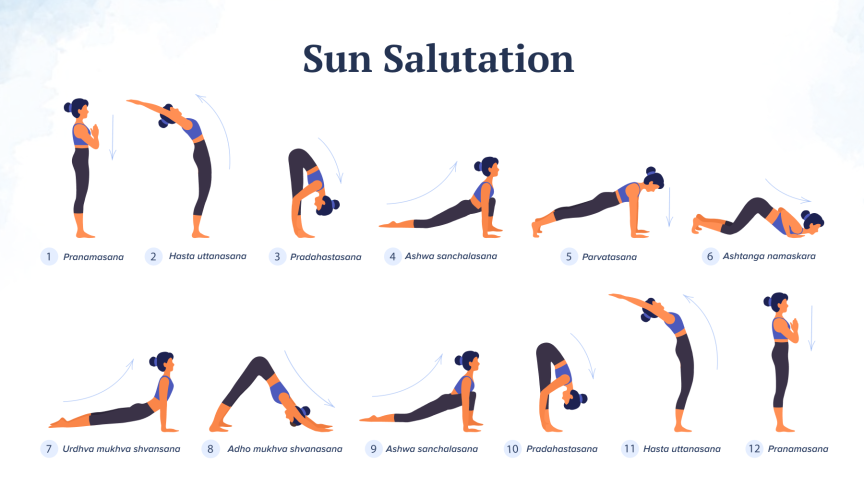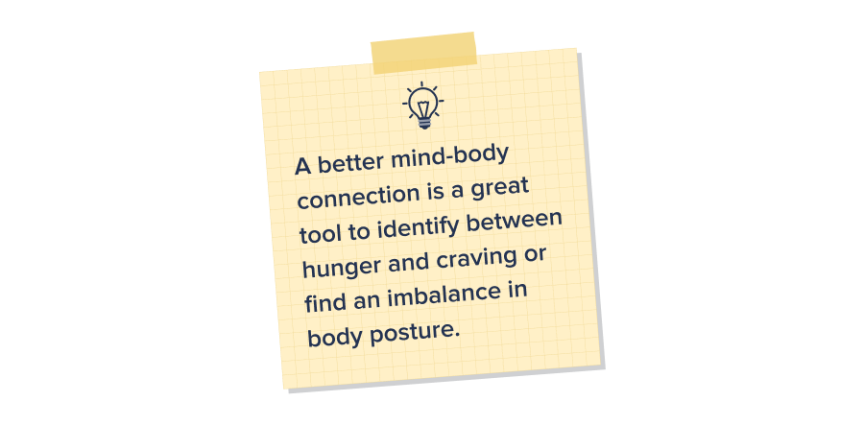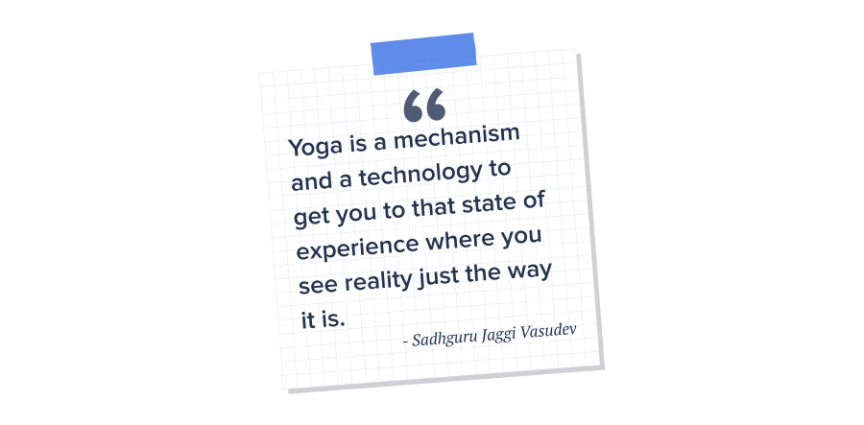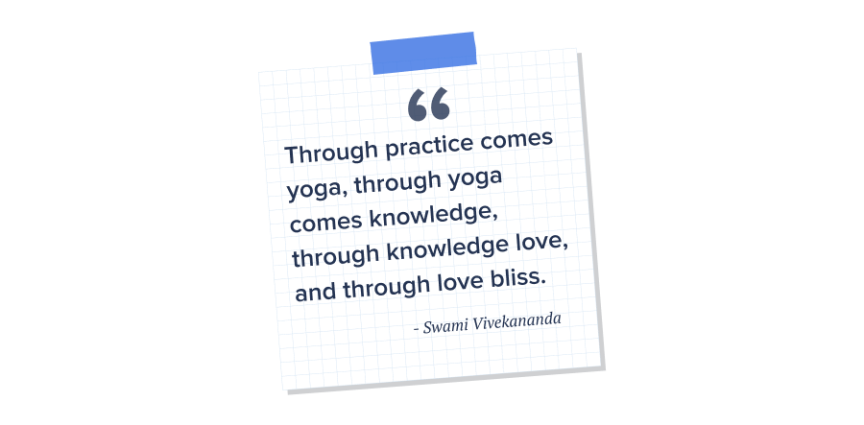Did you know?
-
One in every five people* experiences back pain and other spine-related problems.
-
More than 1/10th** of the Indian population reportedly suffers from non-communicable diseases such as symptoms of diabetes, high blood pressure, and thyroid-related problems.
- Estimates suggest that 200 million Indians*** suffer from mental health problems such as stress and anxiety.
(Sources: *The Hindu | **The New Indian Express | ***The Lancet)
With all these problems overwhelming us, a therapeutic practice like yoga is more relevant to employee wellness than ever.
- Why is yoga suddenly so relevant? What exactly constitutes yoga?
- What are yoga’s benefits, and how to make it accessible to the Indian workforce?
- Even as little as 15 minutes of yoga a day seems to be helping out. How?
Let us find the answers to some of these questions.
What is Yoga?
Yoga originates from the Sanskrit root word "Yuj", which means “to unite”.
Thus, Yoga is a practice of uniting the body, mind, and spirit; and an individual self with the Universal Consciousness.
“Yoga is like music: the rhythm of the body, the melody of the mind, and the harmony of the soul create the symphony of life” - B.K.S. Iyengar, Light on Life
Practising yoga can be one of the ways to live a happy, healthy and meaningful life in today’s world.
While there are various schools of yoga that practice the science with their nuances, all of them constitute three fundamental parts:
a. Asanas - These are the postures and exercises to improve and maintain the body's mobility, flexibility, strength, and endurance. Practising these keeps you fit, healthy, and functional.
b. Pranayama - Pranayama loosely translates as "the practice of breathing". An average human being inhales about 8000 litres of air in a day. Doing pranayama exercises can improve the functioning of the respiratory system by:
- Flushing out toxins, harmful microbes, and waste gases.
- Supplying adequate oxygen to the cells.
- Maintaining and improving our ability to speak and smell.
c. Dhyana: Dhyana, also known as meditation, is a way to achieve mindfulness, and has several benefits and positive side effects. Meditation mainly includes calming our senses through various methods. This practice primarily focuses on improving our mental health and cognition.
d. Additionally, there are other essential aspects of yoga, such as:
-
Adhyaya - Studying and acquisition of knowledge.
-
Mitahara - The right food and eating practices.
-
Seva - Serving the needy.
-
Satsang - Being in the company of good & virtuous people.
“Yoga is not just exercise and asanas. It is the emotional integration and spiritual elevation with a touch of the mystic element, which gives you a glimpse of something beyond all imagination” - Gurudev Sri Sri Ravi Shankar

The 3 fundamental parts of yoga
Why yoga at the workplace?
-
Increased focus and energy - Sitting for 8 hours can slow down the blood circulation in the lower body, depriving body cells of energy for optimum functioning. Prolonged sitting results in the swaying of focus, pushing the best of us into autopilot mode. This can significantly impact the productivity of an employee.
Practices like better breathing, mindfulness, and quick yoga activity breaks (as short as 30 seconds) every hour, can have a tremendous impact in this area.
-
Better posture and flexibility - Longer periods of sitting result in weak muscles and bone joints, especially in the lower body. A standard working position in front of a computer can cause stiff shoulders and neck and a hunched posture. All of these can hurt our confidence and self-worth.
Practising yoga postures naturally improves balance, corrects posture, and improves muscular strength and flexibility. As we age, all these things make us a lot more confident.
-
Improved immunity and better digestion - Unlike other types of strength training, yoga postures focus on the entire body. Practising yoga and pranayama can improve blood circulation and oxygen supply to all body cells. Improved circulation leads to a better lymphatic system and improved metabolism.
With all this, we fall sick less often and can use our vacation days for actual vacations. Less absenteeism and more relaxation naturally make us better at work and home.
-
Less stress and anxiety at work: Practising yoga over time makes you more mindful, calm, and healthy. All these traits make you more focused and productive at work. Combined with less judgement, you are more equipped to cope with everyday stress and are less anxious at work.
As a result, you can enjoy work and achieve a better sense of satisfaction. You feel more valued at the workplace and can naturally stick longer with the same company. Such a workplace can also unleash your creativity and make you an even more valuable member of the team.

Reasons to practise yoga at the workplace
How yoga creates a better mind-body connection for better health
Any physical activity practised over time will have benefits. These benefits can include a healthier heart, less inflammation, better immunity, better posture and balance.
What makes yoga unique is the improved mind-body connection.
Along with meditation, practising asanas and pranayama require a certain amount of mindfulness. As yoga becomes habitual, you will better perceive pleasure, identify pain, and experience any sensation. This improved awareness makes you less judgemental and more aware of what your body and mind are going through. This improved mind-body connection can have a profound impact on health. It can especially be significant in preventing any pain or condition from becoming chronic.
Easy yoga and mindfulness exercises to do at the workplace or desk
Sun salutations - Stretches and engages all major muscle groups and spine. A great warmup for any physical activity. Also known as "Surya Namaskar".
Instructions to perform:
- Stand straight with joined palms and feet together.
- Breathe in. Stretch your arms up as high as possible. Gently arch back, pushing your arms back and pelvis to the front.
- Breathe out and bend forward, touching the ground. Try to keep the knees straight.
- Breathe in. Take the right leg back as far as possible, keeping the right knee on the floor.
- Hold your breath. Take the left leg back, forming a plant position.
- Breathe out. Lower the knees, chest, and chin to the ground. Stretch the hips as high as possible.
- Breathe in. Form the cobra position by stretching the body upward from the pelvis. Keep palms under the shoulder and elbows close to the body.
- Breathe out. Form a mountain pose, pushing the hips as high as possible, with heels on the ground.
- Breathe in. Bring the right foot forward. The left knee should touch the ground.
- Breathe out. Bring the left leg to the front and bend down (palms should touch the feet).
- Breathe in. Come to a standing position, arching back and stretching the arms back.
- Breathe out. Standing tall, come back to the namaste position.

Surya Namaskar: Step-by-step
Asanas to improve spine posture
a. Padmasana - Reduces muscle tension and alleviates stress. Relieves menstrual pain and eases childbirth. Use this posture to meditate or relax.
Instructions to perform:
- Sit down on the floor with your spine erect and legs stretched.
- Bend the right knee and place the right foot over the left thigh. Do the same with the left leg and cross the legs.
- Keep your head straight and spine erect.
b. Vajrasana - Easy position to maintain a straight spine. Helps relieve bloating and resultant pain. Use this posture to meditate or relax.
Instructions to perform:
- Kneel on the floor. Pull both the knees and feet together.
- Seat the hips on the ankles keeping the spine erect and head high. Use a pillow or towel underneath the ankles for support, if required.
c. Badhkonasana - Seated butterfly pose. Reduces soreness from walking or standing. Increases flexibility in the hip area and inner thighs. Stimulates abdominal organs.
Instructions to perform:
- Sit in Padmasana with the spine erect.
- Slowly bring the soles of both feet together and gently pull them towards the pelvis. Hold both feet with your hands.
- Breathing in, bend down from the hips as much as you can.
- Keep breathing. Come back to the seating position if you experience pain.
d. Vrikshasana - Promotes balance and corrects posture. Improves focus and concentration.
Instructions to perform:
- Stand straight and tall.
- Root the left leg firmly into the ground. Lift your right leg and place it against your left thigh. Pro tip: Pick a focal point in front of your eyes and do this while focusing on that point.
- Bring your arms into the namaste position and take them overhead.
- Repeat the process, alternating between the legs.
Breathing activities to reduce acute and chronic stress
a. Bhastrika pranayam - Improves sensory and motor nervous systems. Flushes out toxins and improves lung capacity.
Instructions to perform:
- Take a deep breath. Breathe out through the nose forcefully.
- With the same force, inhale and exhale deeply and thoroughly using diaphragm muscles.
- Exaggerate the movement and repeat for 15 to 20 inhale-exhale cycles for each round.
- Repeat the process for two more rounds.
b. Nadi shodhan pranayam - Clears respiratory channels of irritants and increases oxygen infusion into the body. Reduces stress and anxiety.
Instructions to perform:
- Inhale a deep breath and exhale.
- Inhale another deep breath and close your left nostril. Exhale. Now deeply inhale with your left nostril closed.
- Open your left nostril and close your right nostril. Exhale deeply. Now take another deep inhalation through the left nostril.
- Repeat the process alternating between the nostrils for 3 to 5 minutes.
What can employers do?
-
Conducive infrastructure - Whether building an office from scratch or renting a space, try choosing a location with dedicated space for employee wellness. For example - Choosing a building with lush green open spaces or public parks in the vicinity; looking for real estate with dedicated yoga studios for group sessions or individual practice.
-
Corporate wellness programs - Since the COVID-19 pandemic, working from home has become a reality for many of us. Investing in an annual subscription for yoga programs via mobile apps can be an excellent way to boost employee wellness efforts.
-
Dedicate time and personnel - Encouraging enthusiastic employees to form a yoga group could be an excellent idea. Such groups should be diverse and inclusive of representation from multiple departments to ensure there is no stigma or discrimination. Dedicating weekly time slots could be highly effective as well.
Note: With one of my previous employers, we had a practice called "Wellness Wednesdays", where the company committed a half-hour time slot to wellness activities. Employees generally look forward to such engaging activities.
In closing
With increasing automation, future jobs would require lesser physical labour. Most of the modern-day problems employees face are due to a sedentary lifestyle. Making yoga a part of life has never been more relevant. Whether you are an employer seeking to maximise your employee's potential or an individual trying to improve the quality of life, the time to consider yoga is now. Even if you are an absolute beginner, as little as 10 minutes a day can positively impact your health and well-being!
Schedule a demo to learn how your organisation can get the best employee health and well-being experience with ekincare's commitment to quality.

 The 3 fundamental parts of yoga
The 3 fundamental parts of yoga Reasons to practise yoga at the workplace
Reasons to practise yoga at the workplace
 Surya Namaskar: Step-by-step
Surya Namaskar: Step-by-step
